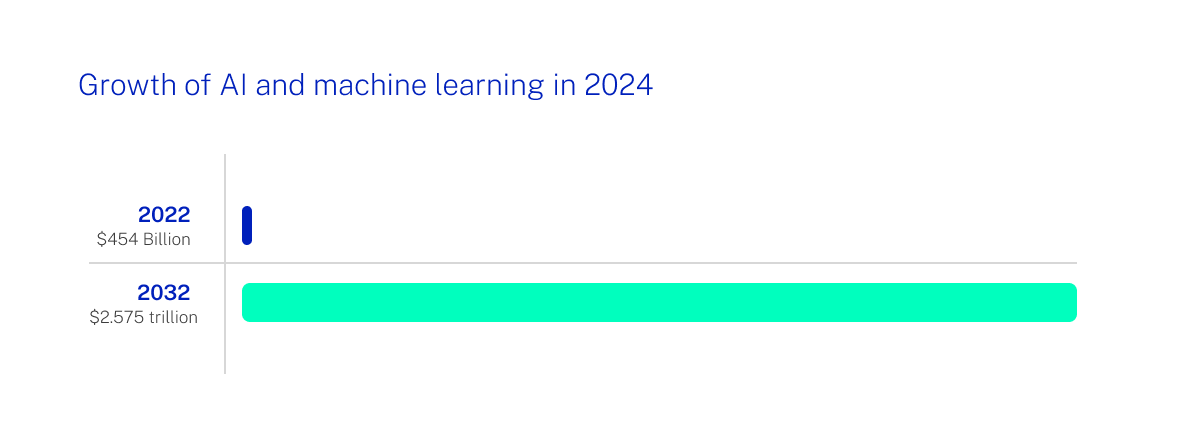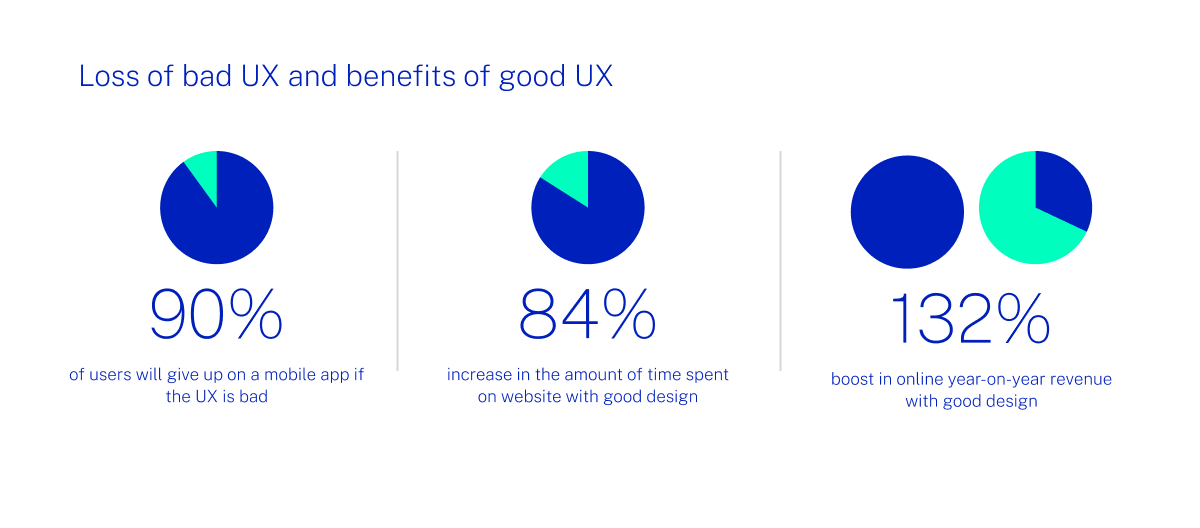Top 10 Software Development Trends for 2025
As technology continues to progress at breakneck speed, software development has to progress just as quickly to enable all the new advances in the world around us. There have also been some fundamental changes in recent years, many of which resulted from the pandemic, whether it’s new ways of working, or an increased use of online retail over physical purchasing. And as we've seen in the last year or two, the proliferation of artificial intelligence is changing the world of technology entirely.
It’s for that reason that software developers and businesses alike have to stay on the pulse of where development is headed, and ensure that they’re on top of new opportunities and innovations. This blog highlights ten of the biggest software development industry trends that will shape 2025, and the years to come.
%20and%20Machine%20Learning.png?width=32&height=32&name=Artificial%20intelligence%20(AI)%20and%20Machine%20Learning.png) Artificial Intelligence (AI) and Machine Learning
Artificial Intelligence (AI) and Machine Learning
2024 will be remembered as the year in which the business world infused more AI and ML into their workflows. According to Gartner, 79% of corporate strategists now say that AI and analytics will be critical to their success over the next two years. But 2025 will be the year that aspirations increasingly turn into reality and the practical uses of AI expand at pace. That’s why it will be one of the biggest AI trends of 2025.
Growth of AI and Machine Learning in 2025
The global AI market was valued at around $454 billion in 2022, according to Precedence Research. But thanks to a healthy compound annual growth rate of 19%, this is expected to reach as much as $2.575 trillion by 2032. Much of this is being driven by innovations in areas that have the most widespread, general and accessible use: think Natural Language Processing for generating written content and code. But there is also growth in the market for ethical AI, as businesses deploying intelligent automation aim to ensure that their use of AI doesn’t result in unintentional bias or discrimination in their products and services.
In 2025, we can also expect an expansion in Agentic AI capabilities, more moves in RegTech and a broadening intersection between AI, IoT, AR and VR. More teams will be developing tools that leave room for integrating agents, sensor-guided control, plus more physical and tactile methods of inputting commands and receiving output when using AI tools.

How This Will Shape Various Industries in 2025
Name an industry and you can pretty much guarantee that AI will be having a major impact on it this year. As a few examples that we’ve noticed among our customers and specialist sectors, finance firms are increasingly turning to AI to spot fraudulent activity faster and minimize any impact; retailers are deploying AI-driven chatbots to increase the speed and efficiency of customer service queries and responses; and the iGaming sector is using AI to better understand individual player preferences, and tailor their experiences for higher satisfaction and improved revenue.
Tool Expansion for Rapid Adoption
What’s also becoming clear is that the advances in AI are so fast that there’s no time to lose in getting AI-driven services and processes up to speed. In order to do that, many businesses actively exploring AI are expanding their use of different tools, and especially those that make AI deployment more efficient, more scalable and less complicated.
 Digital Transformation and Assurance
Digital Transformation and Assurance
Digital transformation will remain as hot a topic as it’s ever been, but what will change in 2025 is the increasing need to integrate it with digital assurance. More and more organizations have come to realize just how complex digital transformation can be, and just how difficult, time-consuming and expensive it can be to get it right.
Digital assurance, embedded alongside transformation, can take a wide enough view of quality control across an entire ecosystem, so that the risk of failure or unexpected problems can be minimized. It can help avoid risks, mitigate mistakes, maximize testing efforts, improve workflow and efficiency, and enable better decision-making from a security standpoint.
 Continuous Delivery and Deployment
Continuous Delivery and Deployment
It has already been one of the most compelling software trends of the last few years, but in 2025, development cycles will become faster and more fluid than they’ve ever been before. Long gone are the days when new functions and features were packaged together into batched releases, along with patches and bug fixes. This approach doesn’t meet user and customer demands to get the latest, most advanced solutions as quickly as possible - and the lag time left development teams vulnerable to being beaten to the punch by competitors.
Instead, continuous delivery and deployment makes the acts of software development, bug-fixing and experimentation constant and ongoing. With continuous delivery, apps are pushed into production for manual download, while automated deployment takes care of software updates. This means that development teams can work on a day-by-day basis to push out fixes, and roll out new functionality as soon as it’s ready.
For this to get to the next level, development teams will be working more closely with marketing, commercial and other teams. The goal is to have a more unified picture where user feedback, business goals and team capacity can all be visualized side-by-side quickly and insightfully. Accordingly, tools that combine beta testing with surveying will become more popular.
 Security Breach Detection and Prevention
Security Breach Detection and Prevention
AI is revolutionizing the world of technology in many positive ways - but it’s doing the same in a number of malicious ways, too. Just as businesses can use AI for better products and services, some cybercriminals are using the same technology to expand the scale, capability and sophistication of their attacks. This will make it harder for security tools to spot and shut down threats before they can impact an organization, and potentially leave end-users more vulnerable to ransomware and phishing attacks that are increasingly convincing.
In short, being reactive in security breach detection and prevention is not going to be enough to keep data, users and applications safe in 2025. It’s time to get proactive, using tools like AI-supported analytics, automated scanning for vulnerabilities, and real-time threat monitoring to head off any threats before they’ve even managed to get started. If you wait until an attack becomes apparent to the security team before starting to respond to it, then it’s already going to be too late.
 Cloud Reliance for Scalability
Cloud Reliance for Scalability
The rise of cloud computing was suddenly accelerated by the pandemic, as millions of workers all over the world needed access to data and applications remotely. But as the pandemic has subsided, flexible and hybrid working is very much here to stay, and that means that the cloud has become an essential part of the business technology world.
The cloud is also proving instrumental in enabling the scalability that is essential for international growth and expansion. In particular, it allows organizations to spin up new teams and projects in new markets almost instantaneously, and to be able to do so without making major capital investments into hardware.
But to be able to achieve that successfully, a reliable cloud platform and deployment, enabling seamless communication, transactions and user experiences, will be critical. Within this trend, we’ll also see more apps developed in a manner that enables them to work with modules facilitating serverless computing.
 Progressive Web Apps
Progressive Web Apps
Businesses developing web apps over the last few years have often found themselves between a rock and a hard place. If they’ve focused on websites, then they’ve maximized accessibility for the widest possible user base, but compromised the ability to get top performance from platform-specific hardware. On the other hand, native apps take full advantage of hardware and software capabilities, but are restricted in their availability to a single platform’s user base.
This is why progressive web apps are gaining so much traction, as they represent the best of both worlds. Delivering app-like experiences within web browsers, built through powerful and platform-agnostic tools, means that both performance and accessibility can be combined without compromise. Google and Adobe in particular have invested heavily in developing progressive apps, and their philosophies are increasingly filtering through to other sectors and organizations.
 Low-code and No-code Development
Low-code and No-code Development
The need to get new innovations and applications into the market as quickly as possible has long clashed with the complexity of software coding. Good coding takes time to complete, and has left many a business walking a tightrope. Take your time to get an app right, and you might miss out on first-mover advantage to a competitor. But try and speed it up too much to meet a tight deadline, and you risk errors and mistakes creeping in.
The solution to this is to bypass much of the coding requirement in the development process, or even all of it entirely. Low-code and no-code development platforms are quickly gaining traction as a faster, more accessible way of creating excellent applications. Drag-and-drop interfaces help apps be created visually, and eliminate the time-consuming need for programmers to get into the granularity of coding specific functions. Not only does this allow innovative apps to get into market faster, without the risk of bugs and errors, but it also allows more people with lower levels of coding skills to do the work themselves.
 UX Through Web Applications
UX Through Web Applications
When end-users have so many software options to choose from, and can shop around easier than ever before, user experience stands out as a key differentiator. For example, if a customer on a retail website or app finds the buying journey slow, stressful, clunky or lacking in personalization, then they won’t hesitate to switch to a competitor that will give them the experiences they want. Up to 90% of users will give up on mobile apps if the UX isn’t up to scratch.

New technologies are continually coming on stream to take user experiences in web applications to the next level. Voice user interfaces, personalization driven by AI, augmented and virtual reality, and inclusive design systems are just some of the innovations that are delivering on user expectations. It won’t be long until these kinds of solutions and functions will be the basic standard in web app UX, so now is the time to start getting on board with them.
 Bridging Web2.0 with Blockchains
Bridging Web2.0 with Blockchains
While blockchain technology is already making significant strides in certain sectors, there are still massive challenges in connecting blockchains to Web2.0 systems. Some excellent examples include the teams running cryptocurrency exchanges, but this is just one use case.
In 2025, there’ll be more developers working on software to support blockchain oracles that send real-world data and randomized outputs to blockchains. They’ll also work on tools that visualize on-chain activity, offering more context than what existing blockchain explorers provide.
These could include dashboards where ownership and transfer of fungible and non-fungible tokens can be interpreted to determine who has kept their end of a business deal. It could also extend to showing that certain products have passed authenticity checks, or that data entered into a system is what actually happened in a real-world business scenario.
 Tightened Data Privacy
Tightened Data Privacy
Data privacy has never been more important, especially in light of how AI tools use and learn from large volumes of data. Regulations in this area have been tightening up for a number of years now, through legislation like GDPR in Europe and CCPA in California, and the demand for greater regulation and wider compliance checks will only grow through 2024 and beyond.
While every responsible business recognizes the importance of this, they will also be keen to ensure that privacy doesn’t come at the cost of quality user experience, and therefore productivity and/or revenue. Striking this balance will be a top priority for software developers this year, in order to develop applications that are both successful and compliant.
 Sustainable and Eco-friendly Practices
Sustainable and Eco-friendly Practices
Laced through everything mentioned above is the need to bake sustainability into every area of a business, including software development. Businesses now face increasing legal obligations to reduce their impact on the environment, as well as the pressing moral and social obligations to do so. For example, at the start of 2024, the European Union introduced a Corporate Sustainability Reporting Directive (CSRD), which requires all large and many small companies operating in the EU to start publicly reporting on their climate impact on an annual basis.
However, achieving sustainability goals will naturally have an effect on how businesses operate. CapGemini research has found that nearly half of global business leaders feel climate change will be the biggest driver of operational disruption over the next ten years. From a software development perspective, this means exploring more sustainable practices like energy-efficient coding, greener cloud computing, sustainable DevOps, and a commitment to educating people on eco-friendly computing.
In Summary: Ciklum Paving the Way for Software Development
If you feel you need help in embracing the biggest software development trends of 2025, then partnering with a software development and AI expert is the way to go. At Ciklum, our software architecture services can give you all the support you need in cutting the complexity, disruption and inefficiencies from your software development processes.
We believe strongly in customer-centric design processes, future-proofed innovation and a holistic approach to development. That way, you can innovate at scale with the latest technology, and ensure you achieve the perfect balance of user experience, scalability and performance.
Find out more on our stand-out approach to software architecture and design in software engineering here.



